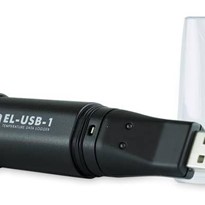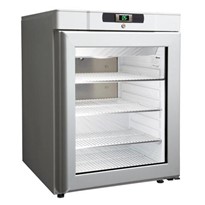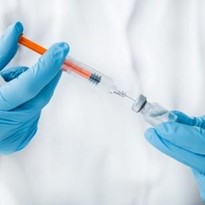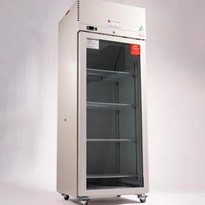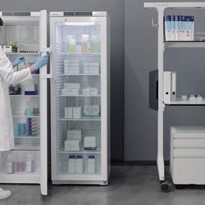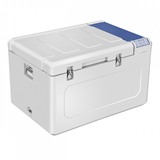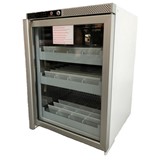Condensation is when there is moisture or fogging on the glass door of the refrigerator because of high humidity levels. As vaccines require strict temperatures to maintain the cold chain, condensation could be an indicator of a temperature breach which could affect the potency and safety of medications. In this article we will explain what condensation is, why it needs to be managed, and how to control it in a vaccine fridge.
What is Condensation?
Condensation occurs when water vapour in the air turns into a liquid. It occurs in vaccine fridges when the warmer air outside the fridge meets the cool air inside the fridge. This is because the glass temperature is below the dew point of the outside temperature and relative humidity. The water vapour in the air that enters the fridge condenses with the cooler air of the refrigerator and turns into liquid that can be seen as fog or droplets on a fridge. Condensation has a higher occurrence in humid areas when ambient temperature is increased.
Importance of Removing Condensation from Vaccine Fridges
It is important to remove condensation from vaccine fridges for several reasons. Droplets of water inside the fridge can form mould, bacteria and yeast that thrive in wet environments. These biofilms can compromise the safety of vaccines. Similarly, if the interior of the fridge is wet, the packaging containing the vaccines can become damp and potentially contaminate the medications.
How to Manage and Reduce Condensation on Vaccine Fridges
There are different ways to manage and reduce condensation on vaccine fridges.
- Select a refrigerator with strong cooling airflow. Strong cooling airflow from the top to the bottom, works as an air curtain to block the external hot air from entering the refrigerator when the door is opened to prevent the temperature in the cabinet from rising rapidly, and minimising the risk of condensation occurring.
- Forced air and evaporator combined. Combining forced air circulation with a finned tube evaporator provides excellent protection against condensation. When forced air circulation is combined with a finned tube evaporator, the fan forces air through the evaporator where it then condenses on the evaporator coils and drains outside the cabinet to evaporate. Fridge evaporators remove heat and water from the air inside the fridge, and provide a consistent cooling effect. The finned tube evaporator acts as a heat exchanger, increasing cooling capacity and condensing excess water vapour at a faster rate than cold plate or cold wall type evaporators.
- Check seals and gaskets on the fridge. Make sure the gaskets and seals are sealing properly. The seal plays a vital role in temperature regulation. To test the seals and gaskets, place a piece of paper between the seal and the refrigerator and close the door. If you can pull the paper out easily, the seal is not working efficiently.
- Well ventilated area. A vaccine fridge needs to be in a well ventilated area to work effectively. The general rule is to have at least 10 cm of open space around the sides, back and top of the fridge for adequate ventilation.
- Make sure the fridge has a low humidity range and a high cooling capacity. Medical fridges should have a humidity range of between 30 and 60 percent, and cooling capacity of 2 to 8 °C.
- Avoid frequent opening of doors. Frequent opening of doors will introduce the ambient air into the vaccine fridge with the potential of causing condensation.
- Weather. Humid areas and non-controlled internal temperatures will impact the likelihood of condensation. If you are in a humid environment, it will be necessary to increase condensation management. In a drier climate, condensation is less likely to occur but still needs to be monitored.
- Regular maintenance and servicing. It is important to have a regular maintenance and servicing schedule to avoid any issues that cause condensation. Schedule maintenance checks by trained technicians to include inspections of the refrigeration system, compressors, fans and seals.
- Wipe down the fridge every day. Remove any excess moisture immediately by wiping down the fridge every day. This will help avoid any build-up of condensation and water droplets that can damage vaccines.
- Invest in a fridge with automatic removal of condensate water. Some pharmaceutical fridges are now designed to automatically remove the condensate water. It is still important to do regular checks but condensate droplets are less likely to occur with this type of technology.
- Level positioning. Make sure the fridge is positioned on a level surface so any condensate can flow to the drain pan. It is better for the water to drain out of the fridge so it can evaporate into the air as opposed to it forming inside the refrigerator which can potentially compromise any stored vaccines.
- Put vaccines in waterproof packaging. As an extra precaution, place vaccines into waterproof packaging. This will add another level of protection should condensation occur.
- Using desiccants. Desiccants like silica gel or calcium chloride are passive dehumidifiers that can remove moisture from the environment. The desiccant absorbs moisture within the package and is often seen in pill bottles or electronics packaging. With regards to a vaccine fridge, there are some safety issues, with the possibility of desiccant becoming a source of contamination.
Methods for Dealing with Condensation on Vaccine Fridge
Should condensation occur in a vaccine fridge, try the following troubleshooting methods.
- Wipe glass down to remove water. It is important to wipe down the glass to remove any moisture as the fridge will also be trying to cool the water droplets on the door, which decreases the vaccine fridge’s effectiveness.
- Let water drain outside the refrigerator. Make sure the water can drain outside the refrigerator, either manually or via the drainage hole.
- Use a dehumidifier or heat pump. A dehumidifier or heat pump is an effective way to warm the dry air in the event of condensation. Because less water is circulating, condensation is less likely to form.
- Slightly lower the outside room temperature. If condensation is building up, the ambient temperature will need to be balanced. By lowering the temperature in the room, you decrease the dew point as the air becomes drier and cooler.
- Professional advice. If condensation keeps occurring, it is recommended that a technician look at the vaccine fridge to see if there are any issues, like damaged seals, causing it.
Condensation is a natural occurrence that happens when humid and cool air meet. Condensation forming in fridges is common but, for safety reasons, it is imperative that it is controlled in medical fridges. Vaccines and other temperature sensitive medications need a strict environment to maintain their effectiveness and potency. Any variations caused by condensation could impact their safekeeping. In this article, we have explained what condensation is, the importance of reducing it, and provided a guide on how to manage and reduce condensation in vaccine fridges. For further information, contact the experts in vaccine cold storage, Eurochill.




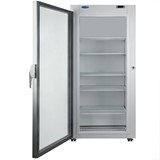
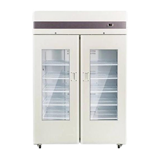
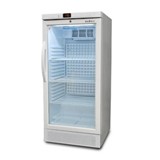
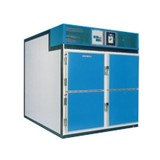
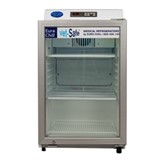



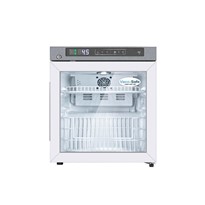








-205x205.jpg)
-205x205.jpg)
-205x205.jpg)
-205x205.jpg)
-205x205.jpg)

-205x205.jpg)






